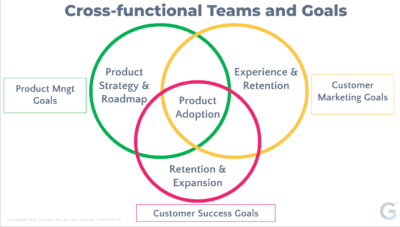Tech touch isn’t just a buzzword that’s thrown around your Slack channel. It’s a way to engage customers with less effort from your team through email, user groups, online communities, and a game-changing new ROI driver: in-product engagements.
Unfortunately, if you’re a product manager or leader, these valuable in-product guides and experiences are probably stirring up extra questions:
- Who should own them?
- What governance should we put in place when multiple teams want to use them?
- What is too much or too little to put in front of the user?
- How do we use them to drive value for customers?
You can answer these questions and help end users unlock value with every interaction in your product with three P’s: people, process, and product.
In part one of a three-part blog series, we walk you through the first secret to unlocking governance around your in-product user guide experience: people. Read on to learn how organizing and engaging the people on your teams can supercharge your in-product user guide experience.

How do you create your product-centered dream team?
Ready to assemble your A-team and start fighting for a better in-product experience? Start by bringing together a cross-departmental all-star team. That means building a steering committee or tiger team that blends the strengths of three essential teams:
- Product
- Customer Success
- Customer Marketing
With those three departments leading the way, you can also draw in other value-adding teams, such as Documentation, Education, and Support to round out input.
Why tap into Product, Customer Success, and Marketing teams?
As you can see in the below Venn diagram, each team has separate goals and KPIs. However, product adoption unites these three teams, and it’s the glue that will bond other team contributors.
Most B2B companies identify product adoption as the key leading indicator toward the overall gross retention rate/net retention rate goals. That’s why breaking down the silos between these teams will be the foundation to drive an orchestrated user experience.
Who should own tracking and instrumentation?
As you’re divvying out roles to your people, you may wonder who needs to own tracking and product instrumentation. This should typically be owned by the Product or Product Operations team because it directly aligns with one of their key goals to make data-driven product roadmap decisions.
To see how customers are using your product, to identify friction points, see drop-offs in workflow completions, identify new feature adoption, and make usability improvements, the Product team should track product usage.
How?
The easiest way is to use an in-product analytics tool, such as Gainsight PX. Advanced tools will make it simple to start instrumentation in a few clicks without any coding.
Who should own in-product experiences and messaging?
Because your customers, marketers, and adoption specialists usually own customer experience and retention through other channels, it only makes sense they should craft the messages for in-product engagements. After all, they’re set up to drive in-product journeys and they’re capable of eliminating disjointed end user experiences.
However, putting marketers in charge of in-product messaging isn’t an absolute must. If using marketers doesn’t make sense at your company, you may want to put another team in the driver’s seat. Just make sure it’s a team such as Customer Success Operations, Product Operations, Education and Documentation, or other central teams that are used to encourage product adoption.
Who should drive the strategy?
Your strategy will depend heavily on your customer journeys and experiences. That’s why partnering with Customer Success teams will be critical in defining your strategy and pushing plans into action.
Traditionally, the Customer Success team works closest with the customer, and they have their fingers on pulse and health score data. This positions the team perfectly to help define in-product adoption paths that feed off the right persona and customer segments.
Who should approve these in-product experiences?
It makes sense to put your steering committee in charge of approving in-product experiences. However, if you need to review every single in-product guide before it goes live, you’re going to face massive product delays.
Wondering how to create processes that streamline approval and help you scale your program quickly?
Stay tuned.
In part two of our three-part series, we’ll lay out how to craft a process that drives more product adoption, engagement, and ROI.
Learn How Businesses are Thinking to Scale While Improving Customer Experience to Match Growth
Download our e-book, Product Led Success: The Professional’s Handbook for strategic and tactical guidance on driving onboarding, adoption, retention, and growth using in-product experiences.

